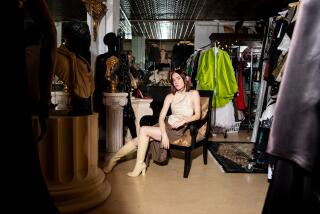Drenched in India’s colors
- Share via
Berenice Geoffroy-Schneiter knew she had tapped into something when a friend who worked for John Galliano told her recently that the designer had become “hypnotized” by India.
“His collection that season was all about India,” said author and art historian Geoffroy-Schneiter of the Paris-based designer. “Like everyone else, he had succumbed.”
What Geoffroy-Schneiter now describes as “Indomania” has resulted in “Indian Beauty: Bollywood Style,” a slim illustrated book recently released in the U.S. by Assouline. In about 80 compact pages (and for under $20), Geoffroy-Schneiter presents the A to Z of Bollywood -- the popular term for the thriving Indian film industry -- and its effect on contemporary fashion, beauty and culture. The release of the book coincides with an ongoing fascination with all things Indian, from the artistic components of the culture -- film, dance, the theater -- to an overall aesthetic.
Notes the Parisian-born Geoffroy-Schneiter: “You see it in clothes, in jewelry. The influences are still strong, and getting stronger.” (An exhibit opening this month at UCLA’s Fowler Museum of Cultural Art called “Traces of India” looks at the links between Indian and Western cultures).
Prosper Assouline, who with his wife, Martine, founded the publishing house in Paris and New York that bears their name, said he commissioned the book because “Indian beauty is exactly what we love in this moment.” Speaking by phone from his office in New York he noted: “There is something very happy about it. It’s not just about the physical, but it is also about the culture.”
Geoffroy-Schneiter is no stranger to non-European cultures. The daughter of a humanitarian-aid doctor, she spent her childhood in Pakistan and Afghanistan. She was 18 by the time she returned to Paris and says she found the first few years back “a very hard adjustment.”
In recent years, she has traveled frequently within India and the subcontinent and has produced books on Asian art, geishas and her memories of Afghanistan.
“Because of my background, I’ve always been very interested in everything Eastern, and especially the contrast between East and West,” she said. “I have been fascinated by the Indian traditions of dance and music and how it translates in life -- the way women do their makeup and wear their clothes based on what they see in Bollywood.” The book is as much a tribute to the intrinsic value of Indian movies as it is to how the worlds of style and fashion are informed by them.
“An ‘Indomania’ ... has wildly gripped fashion and design in recent years, filtering down to people in the street,” the author writes in her book. “Posters, album covers, home-decoration mags, and even haute couture fashion shows ... have reinvented a colorful, festive India wreathed in scents of incense and patchouli.”
When the book was launched in France last month, the initial print run of 10,000 sold out almost immediately. Assouline said that the book’s instant appeal was partly linked to an ongoing retrospective at the Georges Pompidou Center in Paris on Indian cinema, “Let’s Talk Bollywood.”
Noted French embroiderer Francois Lesage -- who works with such designers as Christian Lacroix, Valentino and Chanel -- is now having at least half of the detailed embroidery work on his clothing done in India. Stores from Barneys to the Gap have been selling their versions of the Indian “kurta” -- a round-necked, three-quarter-sleeved shirt featuring threadwork or beads. The faddishness of bindis, bangles and henna-ed hands, explored by American and European hipsters a few years ago, seems to have given way to a much more integrated fusion.
The predominantly visual book contains a series of lush pictures ranging from a suite of northern Indian antique jewelry that would look right at home on any red carpet to stills from the West End musical “Bombay Dreams” (recently transplanted to Broadway). Many of the photos convey the extravagant beauty of the sets and stars of Indian cinema.
Assouline believes says that the Indian influences are here to stay. But instead of producing a weighty tome on the subject, with “Indian Beauty” Assouline went for what he describes as “a small appetizer and nothing more pretentious than that. It should serve as an introduction to people who don’t know very much about Bollywood and the idea of beauty in India.”
More to Read
Sign up for our Book Club newsletter
Get the latest news, events and more from the Los Angeles Times Book Club, and help us get L.A. reading and talking.
You may occasionally receive promotional content from the Los Angeles Times.








